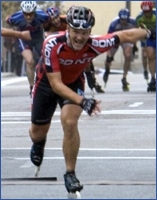 | ||
| ||||||||
Skaters need to think "fall and heel," not "heel and toe." By Randy Plett Skaters always hope for improved performance and added comfort when they buy new boots. But that's not always the way things work out. In more than a few cases, when the new boots arrive, so do a series of painful blisters and hot spots. Skaters often blame the boots. They assume they're the wrong size or were improperly molded. But experience has taught me that the blame usually lies not with the boots but with the technique of the skaters. In fact, as both a coach and a skate retailer, I've found that most skaters who develop problems with new boots are "toe pushers," meaning they tend to push off with their toes at the end of each push.
When skaters push with their toes, the heel of their foot rises off the base of their skates. This raising and lowering of the heel, repeated hundreds or thousands of times, means lots of rubbing. And that causes blisters and hot spots. Skaters in rec or fitness boots can usually get away with toe pushing. Rec skates fit relatively loosely and are heavily padded, so friction is minimized. But speed skates are not so forgiving. Built to fit snugly, they can easily rub you the wrong way. Fortunately, toe pushing is easy to fix — not only that, but correcting it will make you a more powerful and proficient skater. Am I a Toe Pusher? It's easy to tell if you are. Just check your wheel wear. Does your front (toe) wheel show more wear than your back wheels. If so, odds are you are toe-pushing. How to Cure a Toe Push The key to a proper push is to learn to use the natural "fall" of your weight from one skate to the next to power your push. To do this, consciously shift all your weight to your glide foot when you are skating. Then, let your weight "fall" to the opposite foot. Your push will happen naturally. Now, instead of directing your foot out to the side, push it into the pavement. This will help keep your foot from trailing behind you, which generally leads to toe pushing. Remember to push from the heel. Don't allow your skate to drift back behind you. Instead keep it parallel to the other skate. In this way, your heel will stay firmly planted in the base of your boot. As a result, friction will be eliminated — as will blisters and those fruitless attempts to fix boots that really weren't the problem in the first place.
• Red River Speed Related reading: • Skate Tip of the Week Archive
...
Copyright © 2007 by Robert Burnson | ||||||||

 Randy Plett is one of the top pro veteran skaters in North America. He started inline skating in 1994 and has been a member of the Bont North America team for five years. He also skates short- and long-track ice, which, he says, are great for cross-training and also help him refine his technique. He lives in Winnipeg with his wife and three children. He owns Winnipeg's Red River Speed skate shop and works part-time as an oncology nurse.
Randy Plett is one of the top pro veteran skaters in North America. He started inline skating in 1994 and has been a member of the Bont North America team for five years. He also skates short- and long-track ice, which, he says, are great for cross-training and also help him refine his technique. He lives in Winnipeg with his wife and three children. He owns Winnipeg's Red River Speed skate shop and works part-time as an oncology nurse.